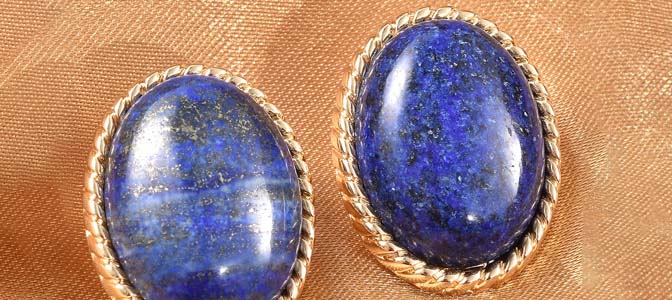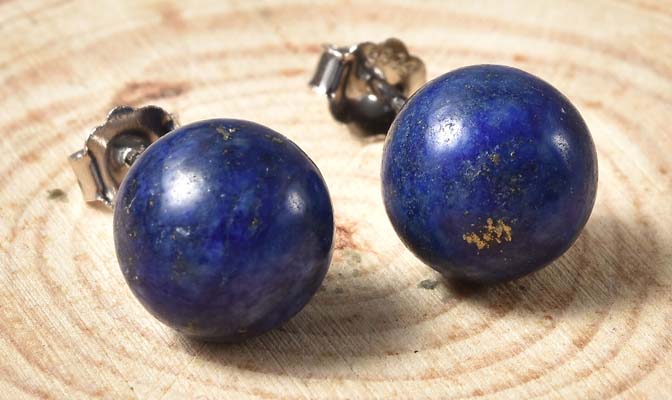No, the gemstone is not very expensive, but a truly fine material is still a little rare.

Introduction
Lapis Lazuli gemstone is widely known for its likeness to the night sky, and its dark blue colour shimmers with golden flecks that resemble shining stars. This gemstone is primarily a deep-blue metamorphic rock that is used as a semi-precious stone.
New Arrivals in Chalcedony

Origin & Supply
The major source of Lapis Lazuli happens to be the mines in North-East Afghanistan. Other notable sources are west of Lake Baikal in Russia, and in the Andes mountains in Chile. Smaller quantities of the gemstone are mined in Italy, Mongolia, The United States of America and Canada.
Geology Lesson
Lapis Lazuli gemstone is created from lazurite, which gives the stone its dark blue colour, and calcite and pyrite crystals, which create the golden star-like flecks. The stones can vary from green-blue to purple-blue, but it is the intense dark blue with golden flecks that are the most highly prized.
Optical Features of Lapis Lazuli Gemstone
Category
Metamorphic rock
Crystal System
None, as lapis is a rock, Lazurite, the main constituent, frequently occurs as dodecahedra.
Colour
Blue, or purple, mottled with white calcite and brassy pyrite
Crystal Habit
Compact, massive
Fracture
Uneven-Conchoidal
Mohs Scale Hardness
5-5.5
Luster
Dull
Streak
Light blue
Specific Gravity
2.7-2.9
Refractive Index
1.5
Other Characteristics
The variation in composition cause a wide variation in the above values.

Interesting Facts About Lapis Lazuli Gemstone
- It is a semi-precious opaque gemstone which is highly known for its intense deep royal blue colour and glitzy golden flecks that are recollections of a starry night sky.
- This beautiful gemstone has an appealing history. Historians believed that it's been almost 6,500 years that Lapis Lazuli gemstone has been around and has been greatly used and treasured by the ancient civilizations of Rome, China, Egypt, Mesopotamia and Greece. Many archaeologists have found proof of Lapis Lazuli among furnishing and treasures in ancient graves. The gemstone wasn't just used into jewellery but also in many other products like figures, bowls, decorative objects etc.
- Michelangelo, a famous painter and sculptor, used ground Lapis Lazuli to deliver an ultramarine coloured pigment for a few of his paintings during the Renaissance period.
- Lapis Lazuli stone is believed to be the first-ever gemstone that was donned as jewellery and had been fashioned into cabochons and beads.
- The gem was used for seals by the Egyptians. They ground it for an eyelid cosmetic and usually crafted it into beautiful vases and figurines.
- Lapis Lazuli is a soft stone which has a hardness of 5-5.5 on the Mohs scale. It is considered to be one of the most valuable semi-opaque stones.

Astrological and Healing Properties of Lapis Lazuli Gemstone
Associations of the Gemstone.
Chakras
Throat Chakra, Third Eye Chakra
Birthstone
September
Zodiac
Taurus, Libra, Virgo, Sagittarius
Vibration
Number 3
Element
Water
Typical Colours
Deep Blue Flecked with Gold (Pyrite)

Lapis Lazuli Gemstone Buyers Tips
Like all other gemstones, the 4Cs: colour, cut, carat weight and clarity are the things you should look for while making a choice. You can always look for a vivid blue coloured lapis lazuli gem, with little impurities, a good size with a fine neat cut.
The origin of the gemstone can also contribute to its overall value. Always remember the simpler the cut is, the more it will exhibit its natural beauty. The most common cuts found in the gemstone are round and oval or usually cut in cabochon. These are some essential things that you can keep in mind while buying Lapis Lazuli gemstone.
History of Lapis Lazuli
It is believed that Lapis Lazuli stone was mined in the Sar-i-Sang mines somewhere in the 7th millennium BCE. The gemstone was also mined in the mines of Badakhshan province in northeast Afghanistan.
Lapis Lazuli originates from the Persian word lazhuward meaning blue, the word meaning heaven or sky, and the Latin lapis meaning stone. Lapis Lazuli began to be imported to Europe by the end of the Middle Ages. The gemstone was also used by the great artist in the Renaissance. When the gemstone was exported to Europe, it was ground into powder and created into ultramarine, the most expensive and finest out of all blue pigments. It is believed that Lapis Lazuli stone was greatly valued in the Indus Valley Civilization and its beads were used in the funeral mask of Tutankhamun. Great Artists like Masaccio, Perugino, Vermeer and Titan often reserved this shining blue gemstone for the clothing of the main figures in their paintings like the stunning Virgin Mary. This alluring gemstone appears in blue colour or purple moulted with white calcite and brassy pyrite.

FAQ's
Is Lapis Lazuli an expensive stone?
How hard is Lapis Lazuli stone?
The hardness of the gemstone is 5-5.5 on a Mohs scale.
What are the healing properties of Lapis Lazuli?
It is believed to bring harmony and can also enhance your in-depth inner self-knowledge.
How should you wear Lapis Lazuli?
According to the astrologers, the gemstone can be worn in gold or silver and should be worn in the middle finger of your correct hand.























